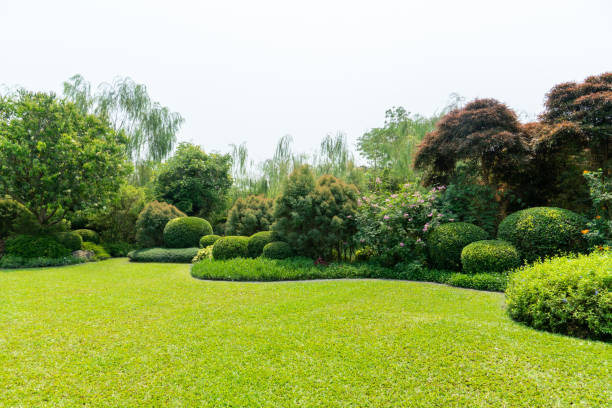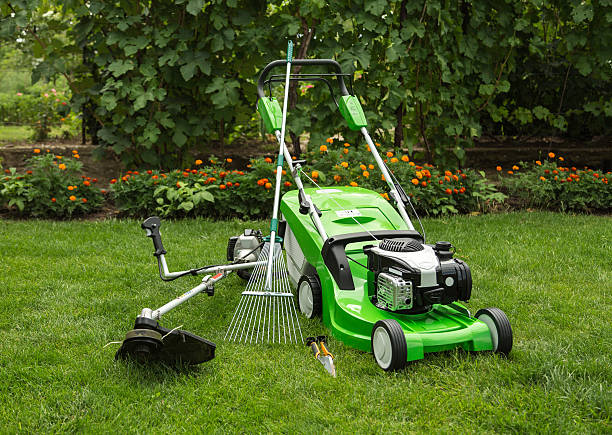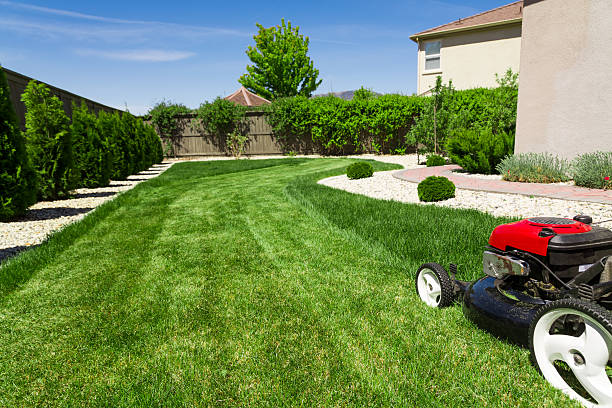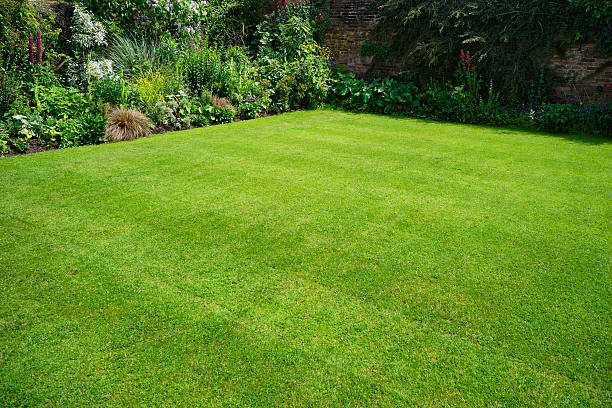Key Differences Between Lawn Care and Boston, MA Landscape Services Explained

When it comes to outdoor maintenance, the terms “lawn care” and “landscaping” are often used interchangeably. However, they refer to distinct practices that serve different purposes. Understanding these differences is essential for homeowners and businesses looking to maintain or improve their outdoor spaces. Below is an in-depth exploration of the primary distinctions between lawn care and landscaping.
1.Scope of Work
- Lawn Care:Primarily focuses on maintaining the health, appearance, and growth of your lawn.
- Mowing
- Aeration
- Fertilizing
- Weed control
- Disease management
- Landscaping:Goes beyond maintenance to involve designing, planning, and constructing outdoor spaces.
- Hardscape installation (e. g.
- Planting shrubs, trees, or flower beds
- Building water features (e. g.
- Installing lighting systems for aesthetic appeal
| Aspect | Lawn Care Tasks | Landscaping Tasks |
| Maintenance | Mowing, fertilizing, aeration | Limited; usually follows project completion |
| Design | None | Includes layout planning and aesthetics |
2.Goal or Objective
- Lawn care focuses on nurturing existing grass and plants to ensure they thrive in their environment. The aim is to preserve a healthy yard with minimal invasive issues such as pests or weeds.
- Landscaping transforms an outdoor space by adding structural elements and improving visual harmony.
For example:
A well-maintained lawn ensures lush greenery throughout the year. Landscaping elevates this space by incorporating pathways framed with flower beds or sculpted hedges.
3.Time Frame
- Lawn care tends to be an ongoing task requiring regular attention—weekly mowing during summer months or seasonal fertilization treatments.
- Landscaping projects are more project-based with a clear start and end point but may involve occasional follow-up maintenance after implementation.
4.Required Expertise
- Lawn care professionals focus on agronomy (soil science), pest control techniques, irrigation management, etc.
- Landscapers often have expertise in architecture, horticulture design principles, hardscaping methods like stonework or masonry.
Both roles require specialized knowledge but cater to different aspects of outdoor aesthetics.
5.Cost Variations
Due to the differing levels of complexity and materials involved: – Lawn care tends to be less expensive since it revolves around routine services performed at frequent intervals. – Landscaping can be costlier as it involves comprehensive designing work along with material procurement (rocks/stones/plants), heavy machinery usage during construction phases among others.
| Service Type | Average Cost Range Per Year |
| Basic Lawn Care Services (mowing/fertilizing) | $500–$1,000 |
| Medium-Level Landscape Installations | $5,000–$15K |
Understanding these distinctions will help property owners make informed decisions based on their goals—whether they seek everyday maintenance through lawn care or a complete transformation via landscaping design solutions
Achieving a Clean and Healthy Landscape with Expert Landscaping Boston, MA Services
Weed eating, often referred to as string trimming, is an essential landscaping task that contributes significantly to the health and appearance of outdoor spaces. Proper weed management goes beyond aesthetics; it ensures that lawns and gardens remain healthy by preventing invasive plants from competing with desired vegetation for nutrients, water, and sunlight. This article dives into why weed eating is crucial and offers tips for effectively incorporating it into your landscaping routine.
Key Benefits of Weed Eating
- Provides a clean and polished look by removing overgrown weeds and grass in hard-to-reach areas.
- Defines the edges of garden beds, sidewalks, driveways, fences, or walls for a professional appearance.
- Reduces competition for resources between weeds and desirable plants such as grass or flowers.
- Helps lower the risk of pest infestations since many weeds harbor insects harmful to gardens.
- Regular trimming stops weeds from seeding and spreading across your landscape.
- Keeps fast-growing invasive species under control before they take over entire sections.
- Clears away tall grass and weeds that may hide hazards like rocks or debris.
- Improves visibility along pathways or driveways.
Best Practices for Effective Weed Eating
- Choose the Right Equipment:
Invest in a high-quality string trimmer with adjustable power settings suitable for different terrains. - Inspect Your Landscape Before Starting:
Identify areas prone to weed growth around flower beds, tree bases, fences, or patios. - Maintain Proper Technique:
Hold the trimmer at an even angle to ensure consistent cuts across all targeted areas. Avoid scalping the ground as this can damage soil health. - Wear Protective Gear:
Use safety goggles, gloves, long sleeves, and work boots to protect against flying debris while operating a trimmer. - Establish a Regular Schedule:
Incorporate weed eating into your monthly landscaping routine to stay ahead of new growth cycles.
Table: Comparison of Mowing vs.
| Aspect | Lawn Mowing | Weed Eating |
| Purpose | Cuts grass evenly over large areas | Trims edges or small spaces inaccessible by mowers |
| Equipment | Push mower or riding mower | String trimmer (electric/gas-powered) |
| Target Areas | Open lawns | Fence lines, tree bases, garden borders |
| Frequency | Weekly or biweekly | As needed (1–2 times per month) |
Areas That Benefit Most From Weed Eating
- Around fences: Prevent weeds from tangling through chain links or wooden posts.
- Alongside sidewalks: Ensure clean walking paths free from intrusive vegetation.
- At the base of trees: Avoid letting weeds choke out saplings or mature trees.
- Near garden beds: Preserve defined edges while preventing unwanted plant intrusion.
Properly implementing weed eating into your landscaping practices can significantly enhance both functionality and curb appeal. By staying consistent with this maintenance task, you’ll create not just visually appealing outdoor spaces but also healthier environments where desired plants thrive without interference from invasive species.
Maintaining Boston, MA Landscapes: The Importance of Weed Eating for Clean and Healthy Spaces
Weed eating, often referred to as string trimming, is a crucial component of maintaining a well-kept and thriving landscape. This process not only improves the aesthetic appeal of your outdoor space but also contributes significantly to the overall health of your lawn and garden. Below, we’ll explore why weed eating is essential, its benefits, and how it plays an integral role in landscape maintenance.
Benefits of Weed Eating
- Weed eaters are perfect for reaching areas that mowers cannot access.
- They create sharp edges along sidewalks, driveways, fences, and flower beds.
- Helps maintain a clean, polished look by removing overgrowth.
- By trimming weeds before they seed, you prevent their spread across your lawn and garden.
- Reduces competition for resources like water and sunlight among desirable plants.
- Eliminates invasive plants that may harbor pests or diseases.
- Prevents weeds from choking out turfgrass or ornamental plants.
- Keeps pathways clear and safe for walking by removing overgrown vegetation.
- Helps ensure proper visibility in outdoor spaces.
Weed Eating vs.
| Aspect | Mowing | Weed Eating |
| Primary Use | Cuts grass evenly across open areas | Targets edges & hard-to-reach spots |
| Equipment Used | Lawn mower | String trimmer (weed eater) |
| Effectiveness on Weeds | Limited (only trims the surface) | Removes weeds at their base |
| Best For | Large, flat spaces | Edges, corners & vertical surfaces |
Using both techniques together ensures comprehensive maintenance for your outdoor space.
Key Areas That Need Regular Weed Eating
- Around trees and shrubs – Prevents overgrowth near trunks while protecting bark from damage.
- Edges along driveways or sidewalks – Creates crisp borders that enhance curb appeal.
- Fence lines – Keeps vegetation from intertwining with fences or damaging structures.
- Flower beds – Removes stray weeds without disturbing planted flowers or mulch layers.
Tips for Effective Weed Eating
- Choose the right string trimmer:Electric models are quieter and environmentally friendly, whereas gas trimmers offer more power for larger spaces.
- Use protective gear:Wear safety glasses to shield your eyes from debris during operation.
- Hold at an optimal angle:Tilt the trimmer slightly to avoid scalping the ground or damaging nearby plants.
- Adopt regular intervals:Frequent trimming helps control growth before it becomes unmanageable.
Incorporating weed eating into your landscaping routine can dramatically improve both the appearance and health of your outdoor space. By addressing invasive growth early on and targeting hard-to-reach areas, you ensure a clean environment where cultivated plants can flourish without competition from stubborn weeds.
Enhance Your Outdoor Space with Expert Landscapers Boston, MA
Professional lawn mowing is more than simply running a mower over your grass. It’s a critical component of maintaining a healthy, vibrant, and visually appealing lawn. By utilizing proper mowing techniques, homeowners can ensure that their outdoor spaces not only remain aesthetically pleasing but also thrive year-round. Below, we explore the key practices and benefits of professional lawn mowing.
Benefits of Professional Lawn Mowing
- Healthier Grass Growth: Proper mowing promotes even distribution of sunlight, water, and nutrients, stimulating healthy grass growth.
- Improved Aesthetic Appeal: Consistent and precise mowing enhances the uniformity and overall appearance of your lawn.
- Prevention of Pests and Diseases: Overgrown grass can create an ideal habitat for pests and diseases. Routine mowing minimizes these risks.
- Increased Property Value: A well-maintained lawn significantly boosts curb appeal and property value.
Méndez Landscaping and Construction
82 Havre St,
Boston, MA 02128
+16177126783
https://mendezlandscapingconstruction.com
Proper Lawn Mowing Techniques
- Adjust the mower blade based on grass type.
- Most lawns thrive when grass is kept between 2. 5 and 4 inches.
- A consistent schedule prevents stress on the grass, allowing it to grow stronger.
- Ensure mower blades are sharp for clean cuts, which reduce the risk of tearing and disease.
- Dull blades can damage grass, leaving it vulnerable to pests and infections.
- Change the direction of mowing each time to avoid soil compaction and encourage upright growth.
- Grass clippings can act as a natural fertilizer by returning nutrients to the soil through decomposition.
Comparison of Mowing Techniques
| Mowing Factor | Professional Approach | Common DIY Practice |
| Blade Maintenance | Regularly sharpened for optimal performance | Often neglected or infrequent sharpening |
| Mowing Height Adjustment | Customized for grass type | Default blade height used without adjustment |
| Frequency | Scheduled based on season and growth rate | Irregular or reactive mowing |
| Equipment Quality | High-quality, well-maintained tools | Basic equipment with minimal upkeep |
Why Choose Professional Lawn Mowing Services?
- Custom Solutions: Professionals tailor their techniques to suit specific lawn types, soil conditions, and local climate factors.
- Time Savings: Outsourcing lawn mowing frees up your schedule while guaranteeing consistent care and maintenance.
- Advanced Equipment: Professional-grade tools achieve finer cuts, better edging, and more even trimming compared to standard DIY equipment.
Transforming your outdoor space begins with attention to detail in every aspect of lawn care. Professional lawn mowing techniques take the guesswork out of maintaining your yard while providing healthier grass, improved aesthetics, and long-term value for your property.
Enhancing the Appearance of Your Landscape Design Boston, MA
Maintaining a clean and polished outdoor space is essential for creating a welcoming and attractive landscape. One often overlooked yet highly effective method for achieving this is blowing debris away. This task not only improves the visual appeal of your property but also contributes to the long-term health of your lawn and garden. Below, we explore the importance of debris removal, tools and techniques that can make the process efficient, and additional benefits it provides.
Why Debris Removal Matters
Debris such as leaves, twigs, grass clippings, and dirt can quickly accumulate in your outdoor space.
- Blocked Drainage:Piles of debris can clog gutters and drainage systems, leading to water pooling and potential damage to your lawn.
- Pest Attraction:Organic material attracts pests such as ants, rodents, and insects, which may harm your plants.
- Fungal Growth:Moisture trapped under layers of leaves can create the perfect environment for mold and mildew, affecting nearby plants.
- Unsightly Appearance:Accumulated debris detracts from the overall aesthetics of your property.
Tools for Effective Debris Blowing
Investing in the right equipment can make debris blowing an efficient and straightforward process.
| Tool Type | Description | Best For |
| Cordless Leaf Blower | Battery-powered, lightweight, and portable | Small to medium-sized yards |
| Gas-Powered Leaf Blower | High power and suitable for heavy-duty tasks | Large properties |
| Electric Leaf Blower | Requires a power source, quieter operation | Suburban or urban settings |
| Backpack Leaf Blower | Comfortable for prolonged use | Professional landscaping tasks |
When choosing a tool, consider factors such as the size of your property, noise levels acceptable in your neighborhood, and the type of debris you need to remove.
Key Techniques for Blowing Debris
- Work with the Wind:Align your blowing direction with natural wind patterns to reduce the effort required.
- Start from the Edges:Begin at the edges of your property and move toward a central collection point.
- Use a Tarp or Garbage Bag:Direct debris onto a tarp or into a large bag for easy disposal.
- Adjust Power Settings:Lower settings should be used near delicate plants, while higher settings work well for hard surfaces like patios or driveways.
Additional Benefits of Debris Blowing
- Encourages better air circulation around plants, reducing the risk of disease.
- Prevents slippery surfaces on walkways caused by wet leaves.
- Enhances the curb appeal of your home, which is especially beneficial if you’re planning to sell.
By incorporating debris blowing into your landscaping routine, you’ll ensure that your outdoor space not only looks pristine but also remains healthy and functional throughout the seasons.
Top-Quality Services from a Professional Landscaper in Boston, MA
Landscaping goes beyond just mowing lawns or planting flowers. It encompasses a wide range of services designed to create and maintain outdoor spaces that are both functional and visually appealing. Whether you’re looking to boost your curb appeal or create a backyard retreat, understanding the available landscaping services can help you choose the right options for your needs. Below is an overview of common landscaping services and how they can enhance your property.
Design and Planning Services
A well-thought-out design is the foundation of any successful landscaping project. Professional landscape designers work with clients to create a customized plan tailored to their preferences, property layout, and budget.
- Site analysis: Assessing soil quality, drainage, and sunlight conditions.
- Conceptual designs: Drafting initial sketches or digital designs for client review.
- Master plans: Creating detailed blueprints that include plant placement, hardscape features, and lighting.
This step ensures that every element works harmoniously to achieve aesthetic balance and functionality.
Hardscaping
Hardscaping involves the non-living elements of landscaping that add structure and durability to outdoor spaces. These features are ideal for creating focal points or enhancing usability.
Examples include: – Patios: Providing a comfortable area for outdoor furniture or dining.Retaining walls: Preventing soil erosion while adding depth to landscapes.Walkways: Guiding movement throughout the property with concrete, stone, or brick paths.Water features: Adding tranquility through fountains, ponds, or waterfalls.
Hardscaping materials are chosen based on durability, style preferences, and budget considerations.
Softscaping
Softscaping focuses on living elements like plants and trees that breathe life into your landscape. A well-executed softscape plan ensures year-round beauty while supporting biodiversity.
Key components include: – Plant selection: Choosing native plants, shrubs, trees, or flowers suitable for local climate conditions.Seasonal installations: Updating flora based on seasonal changes (e. g. , summer blooms vs. winter evergreens).Mulching: Enhancing soil health while reducing weed growth around plant beds.
A thoughtful combination of hardscapes and softscapes creates a balanced outdoor environment that’s both vibrant and sustainable.
Lawn Care Maintenance
Maintaining a healthy lawn is critical for overall landscape appeal. Regular maintenance keeps lawns lush while reducing weeds or pests.
Services typically offered: – Mowing at appropriate heights based on grass type. – Aeration to improve soil health by increasing oxygen flow. – Fertilization programs tailored to seasonal needs. – Weed control using safe herbicides or organic alternatives.
A consistent lawn care routine ensures long-term vitality and enhances property value significantly.
Specialty Features
Many homeowners seek unique touches that set their outdoor spaces apart from others.
| Feature | Purpose | Examples |
| Outdoor Lighting | Extends usability after dark | Pathway lights, string lights |
| Outdoor Kitchens | Creates entertainment zones | Grills, countertops |
| Fire Features | Adds warmth during cooler evenings | Fire pits, fireplaces |
| Irrigation Systems | Ensures proper hydration for plants | Drip systems |
Investing in these specialty features not only makes your space more enjoyable but also increases its potential resale value.
Seasonal Cleanup Services
Changing seasons often bring different challenges like fallen leaves in autumn or overgrown shrubs in spring.
Tasks may include: – Leaf raking and removal. – Pruning dead branches from trees/shrubs. – Cleaning debris from garden beds after winter snowmelt.
Regular upkeep simplifies transitions between seasons while keeping outdoor areas tidy at all times.
Incorporating these services into your landscaping plan allows you to maximize both beauty and practicality within any budget framework.
How Client Testimonials Highlight the Best Landscaping Companies in Boston, MA
Client testimonials serve as a powerful tool for understanding the true value and impact of exceptional landscaping services. They provide a window into the experiences of previous customers and highlight key aspects of service quality, craftsmanship, and professionalism. Let’s explore how these testimonials can shape perceptions and guide potential clients in making informed decisions.
Building Trust Through Authentic Experiences
Customer reviews showcase real-world experiences that can help build trust with potential clients.
– Reliability:Clients often mention punctuality, consistency, and adherence to agreed timelines.
– Attention to Detail:Testimonies frequently emphasize meticulous care taken by landscaping teams to meet specific client needs.
– Professionalism:Reviews highlight clear communication, respect for property, and professional attitudes displayed by staff.
For instance, a client review might state:
“The landscaping team transformed our backyard within budget and ahead of schedule while keeping us informed every step of the way.”
Such statements reassure prospective clients that they are more likely to receive dependable and high-quality service.
Highlighting Unique Service Offerings
Testimonials often shed light on specialized or unique aspects of a company’s services, including:
– Custom designs for gardens or outdoor spaces tailored to individual preferences
– Use of eco-friendly practices or sustainable materials
– Expertise in handling specific challenges like poor soil conditions or uneven terrain
Consider this example from an actual testimonial:
“Their team designed a drought-resistant garden that not only looks stunning but also drastically cut down on our water usage.”
Such feedback helps companies stand out by emphasizing their ability to cater to diverse needs.
Demonstrating Long-Term Customer Satisfaction
Satisfied customers frequently comment on the longevity of the results they receive from landscaping professionals.
– Durability of hardscaping features like patios or walkways
– Healthier lawns and plants due to expert care techniques
– Continued support through maintenance services after initial projects are completed
| Aspect | Testimonial Highlights |
| Lawn Care | “Our lawn has never looked greener after their seasonal treatments.” |
| Retaining Walls | “The stone wall they built has stood strong through every storm.” |
| Maintenance Plans | “We’ve been using their maintenance services for two years with fantastic results.” |
This demonstrates how landscaping companies contribute lasting value beyond just aesthetics.
Encouraging New Clients to Take Action
Reviews play an essential role in motivating hesitant customers to take action. Potential clients looking for reassurance can identify with previous experiences shared in testimonials.
– “We were unsure about hiring professionals at first but are so happy we did.
– “Their team made the process stress-free from start to finish.
These sentiments help potential clients feel confident about reaching out for consultations or quotes without hesitation.
Final Thoughts on Lawn Care Boston, MA
Client testimonials carry immense weight in showcasing how exceptional landscaping services can transform outdoor spaces effectively and professionally while fostering trust among potential customers. By focusing on authentic feedback, businesses not only highlight their strengths but also create opportunities for continuous growth based on customer needs and expectations.
- Key Differences Between Lawn Care and Boston, MA Landscape Services Explained
- Exploring the Beauty and Benefits of Boston, MA Landscapes: Lawn Care vs. Landscaping
- Key Differences Between Lawn Care and Landscaping Boston, MA
- Understanding Cool-Season and Warm-Season Grasses for a Stunning Boston, MA Landscape
- Essential Lawn Care Services and Boston, MA Landscape Offerings for Your Customers
- How Boston, MA Landscape Design Can Enhance Your Outdoor Space
- Understanding the Difference Between Lawn Care and Boston, MA Landscapes








